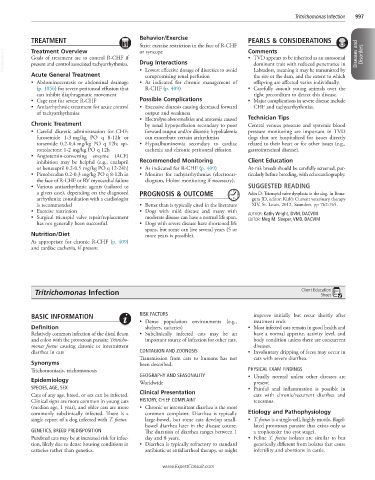Page 1990 - Cote clinical veterinary advisor dogs and cats 4th
P. 1990
Tritrichomonas Infection 997
TREATMENT Behavior/Exercise PEARLS & CONSIDERATIONS
Strict exercise restriction in the face of R-CHF Comments
VetBooks.ir Goals of treatment are to control R-CHF if Drug Interactions • TVD appears to be inherited as an autosomal Diseases and Disorders
Treatment Overview
or syncope
present and control associated tachyarrhythmias.
dominant trait with reduced penetrance in
Acute General Treatment • Lowest effective dosage of diuretics to avoid Labradors, meaning it may be transmitted by
the sire or the dam, and the extent to which
compromising renal perfusion
• Abdominocentesis or abdominal drainage • As indicated for chronic management of offspring are affected varies individually.
(p. 1056) for severe peritoneal effusion that R-CHF (p. 409) • Carefully auscult young animals over the
can inhibit diaphragmatic movement right precordium to detect this disease.
• Cage rest for severe R-CHF Possible Complications • Major complications in severe disease include
• Antiarrhythmic treatment for acute control • Excessive diuresis causing decreased forward CHF and tachyarrhythmias.
of tachyarrhythmias output and weakness
• Electrolyte abnormalities and azotemia caused Technician Tips
Chronic Treatment by renal hypoperfusion secondary to poor Central venous pressure and systemic blood
• Careful diuretic administration for CHF: forward output and/or diuresis; hypokalemia pressure monitoring are important in TVD
furosemide 1-3 mg/kg PO q 8-12h or can exacerbate certain arrhythmias dogs that are hospitalized for issues directly
torsemide 0.2-0.4 mg/kg PO q 12h; spi- • Hypoalbuminemia secondary to cardiac related to their heart or for other issues (e.g.,
ronolactone 1-2 mg/kg PO q 12h cachexia and chronic peritoneal effusion gastrointestinal disease).
• Angiotensin-converting enzyme (ACE)
inhibition may be helpful (e.g., enalapril Recommended Monitoring Client Education
or benazepril 0.2-0.5 mg/kg PO q 12-24h) • As indicated for R-CHF (p. 409) At-risk breeds should be carefully screened, par-
• Pimobendan 0.2-0.3 mg/kg PO q 8-12h in • Monitor for tachyarrhythmias (electrocar- ticularly before breeding, with echocardiography.
the face of R-CHF or RV myocardial failure diogram, Holter monitoring if necessary).
• Various antiarrhythmic agents (tailored to SUGGESTED READING
a given case), depending on the diagnosed PROGNOSIS & OUTCOME Adin D: Tricuspid valve dysplasia in the dog. In Bona-
arrhythmia; consultation with a cardiologist gura JD, editor: Kirk’s Current veterinary therapy
is recommended • Better than is typically cited in the literature XIV, St. Louis, 2012, Saunders, pp 762-765.
• Exercise restriction • Dogs with mild disease and many with AUTHOR: Kathy Wright, DVM, DACVIM
• Surgical tricuspid valve repair/replacement moderate disease can have a normal life span. EDITOR: Meg M. Sleeper, VMD, DACVIM
has not generally been successful. • Dogs with severe disease have shortened life
spans, but some can live several years (5 or
Nutrition/Diet more years is possible).
As appropriate for chronic R-CHF (p. 409)
and cardiac cachexia, if present
Tritrichomonas Infection Client Education
Sheet
BASIC INFORMATION RISK FACTORS improve initially but recur shortly after
• Dense population environments (e.g., treatment ends
Definition shelters, catteries) • Most infected cats remain in good health and
Relatively common infection of the distal ileum • Subclinically infected cats may be an have a normal appetite, activity level, and
and colon with the protozoan parasite Tritricho- important source of infection for other cats. body condition unless there are concurrent
monas foetus causing chronic or intermittent diseases.
diarrhea in cats CONTAGION AND ZOONOSIS • Involuntary dripping of feces may occur in
Transmission from cats to humans has not cats with severe diarrhea.
Synonyms been described.
Trichomoniasis, trichomonosis PHYSICAL EXAM FINDINGS
GEOGRAPHY AND SEASONALITY • Usually normal unless other diseases are
Epidemiology Worldwide present
SPECIES, AGE, SEX • Painful anal inflammation is possible in
Cats of any age, breed, or sex can be infected. Clinical Presentation cats with chronic/recurrent diarrhea and
Clinical signs are more common in young cats HISTORY, CHIEF COMPLAINT tenesmus.
(median age, 1 year), and older cats are more • Chronic or intermittent diarrhea is the most
commonly subclinically infected. There is a common complaint. Diarrhea is typically Etiology and Pathophysiology
single report of a dog infected with T. foetus. large-bowel, but some cats develop small- • T. foetus is a single-cell, highly motile, flagel-
bowel diarrhea later in the disease course. lated protozoan parasite that exists only as
GENETICS, BREED PREDISPOSITION The duration of diarrhea ranges between 1 a trophozoite (no cyst stage).
Purebred cats may be at increased risk for infec- day and 8 years. • Feline T. foetus isolates are similar to but
tion, likely due to dense housing conditions in • Diarrhea is typically refractory to standard genetically different from isolates that cause
catteries rather than genetics. antibiotic or antidiarrheal therapy, or might infertility and abortions in cattle.
www.ExpertConsult.com

